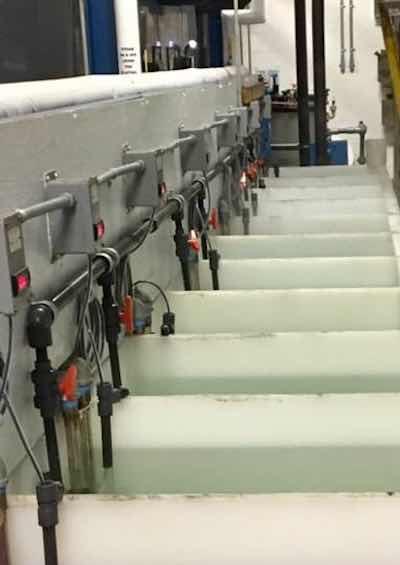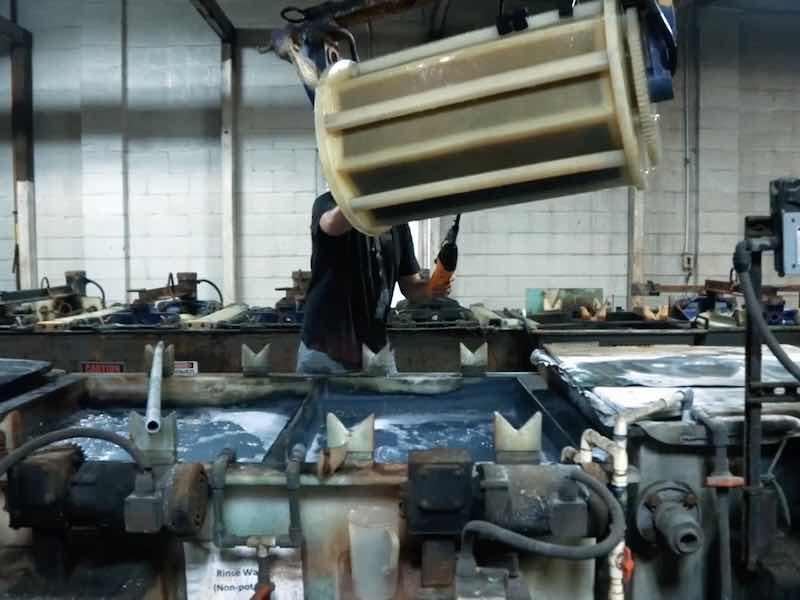Closed-loop systems eliminate wastewater discharge and the associated regulatory burden and liabilities for many finishing and coating shops.
 Mark MillerThere are often substantial cost savings versus conventional systems that allow expansion of on-site plating capacity. Mark Miller, who is in sales and technical services at Hubbard-Hall, discusses the features and benefits of a closed-loop system with Tim Pennington, Editor-in-Chief
Mark MillerThere are often substantial cost savings versus conventional systems that allow expansion of on-site plating capacity. Mark Miller, who is in sales and technical services at Hubbard-Hall, discusses the features and benefits of a closed-loop system with Tim Pennington, Editor-in-Chief
Miller has almost 25 years of pretreatment experience, focusing on phosphate and zirconium conversion coatings. He has extensive expertise in helping customers improve their quality and process efficiencies.
Tim Pennington: What is a closed loop according to your definition? I know some people have different definitions, but what is your definition of a closed-loop system? What is it, and what are the advantages of that?
Mark Miller: A closed loop system essentially is a chemical process that generates zero waste to drain in, essentially, so no part of that process, so let's say you've got a five-stage system, and really, it's managing the rinse water that comes off of those systems. In some applications, we have found that we've worked with many customers to create closed-loop systems, and we can manage that waste stream differently instead of having it go to the drain, eliminating many headaches for the customer. So, it's moving rinse water upstream. So specifically, let's say a customer has a five-stage process; Cleaner Tank Number 1 would obviously be a cleaner, and then you would have a rinse after that. And anytime Tank Number 1 would deplete from evaporation or drag over, we would refill Tank 1 with Number 2. So, any water we put into that system would go into those rinse tanks just to maintain as clean rinses as possible. And at the same time, not discharging anything to drain. And there are some significant advantages to doing that.
Municipalities are tightening up their constraints on what we can discharge down the drain. So, where you may have complied before, now you're not.
TP: Is this different than a zero-discharge system?
MM: Well, no. I mean a closed loop with zero discharge, the same thing. Essentially, the same, same. However, you can focus solely on one process component in some applications. If it's an area that is causing a lot of headaches for maybe an exceedance of zinc or phosphorus or something like that, maybe it is as simple as just focusing on closing off those, that particular area to go to drain, and we manage just that one area that is causing the headache. So, it doesn't necessarily mean it has to be a complete closed-loop system; maybe it is just one part. Ultimately, with the way the environmental constraints are going with municipalities, we try to shut the whole thing right off and put it down the drain.
TP: Why would a customer, why would an operation consider going to a closed loop system? What are some of the benefits that they would see from that?
MM: Well, the biggest challenge we're seeing right now is just exceedances; environmental exceedances will drain. So, municipalities are tightening up their constraints on what we can discharge down the drain. So, where you may have complied before, now you're not. That's the big reason; it is just helping the customer regain compliance so they're not being surcharged fines. I mean, there's a whole lot of things that the municipalities can put down on a customer as far as, I've even seen municipalities go as far as putting a cease and assist on the doors of a customer saying they have to cease the operation until they address the issue. So, you have to figure out if it makes sense to spend tens of thousands of dollars to put in a waste treatment system where you can treat water in-house before it goes to the drain. That's a significant cost, and getting equipment takes a long time. Maybe that's the long-term goal, but the short-term goal could be taking your current system and making it a closed-loop, zero-discharge system.
Upfront Costs, But Big Savings
 TP: I guess when you have a discharge permit, especially with the EPA, that opens up many more problems. Anytime people talk about going to a system, they look at some upfront costs, but there are some cost savings. I mean, there are cost savings to having a closed-loop system.
TP: I guess when you have a discharge permit, especially with the EPA, that opens up many more problems. Anytime people talk about going to a system, they look at some upfront costs, but there are some cost savings. I mean, there are cost savings to having a closed-loop system.
MM: Yes. The one big one they'll notice is the water savings. So, if your general overflow rate is three to five gallons a minute, you're talking thousands of gallons a day in process water just going to drain; we're only going to use a fraction of that. So, the savings will start just in the amount of water you use and then just in the reporting and management of the waste system. You've got third-party testing, audits you have to do, and all the requirements that the municipalities want you to test for. You're talking a lot of man-hours, and with a closed-loop system, all that goes away. You're not discharging anything, so you no longer need to manage anything for them. Now, there are things internally that we have to manage; I mean, we're not sending a lot of waste to drain. So, we still have the waste stream; how we manage that is different.
TP: What potential issues could come up with having a closed-loop system?
MM: So, really, there's no issues. I mean, it's just how we manage it that's different. So, like our rinse waters, where we would normally let those go to drain, we have to start looking at pHs, total dissolved solids, conductivity, etc. So, we can manage those rinses because our overflow rates are greatly diminished. So, we still have those soils in there, but what is the longevity of that process or that particular tank? And it's not necessarily a downside; it's just kind of learning what that new dump schedule will look like. Because, like anything, I mean, we're introducing a lot of solids into the process, and eventually, we're going to have to do something with them. And that's the key: learning, tracking, and testing those different tanks. Once you get your baseline, we can go into a normal discharge schedule, whether quarterly, annually, or semi-annually. It depends; every process will be slightly different, Tim.
TP: Does it take a lot to manage a closed-loop system?
MM: The goal is to keep the rinses as clean as possible. We're using that rinse water upstream and filling up the cleaner tanks, the iron phosphates or zirconium tanks, or whatever our pre-treatment is. And really, the goal is keeping... Once the customer understands how that water or that waste stream moves and how we manage it, it's super easy. It's super easy. Then, we will have dump schedules that we will have to manage as we run the process and throughout the year. But it's significantly cheaper to hire an outside party to come in and clean those tanks out than to deal with the city and all of the reporting, discharge permits, and requirements that are constantly changing and moving. And they're always setting a different standard, and the bar's constantly moving. This is so easy. And I will say, not every chemical process out there, can you turn it into a closed loop zero discharge system? I mean, there are just some out there that are just the type of process, chemical process it is, and it's just not deemed necessary. I mean, there's just no way you can make it happen. But there are a lot of others; powder coating, for example, is a great process to consider. Those are the majority of the processes we convert to closed loop, our powder coating type systems.
In general, you shouldn't really have to change anything on the line. It's just really how we manage the waste that's being generated.
TP: Are there any special chemicals required to run a closed-loop system, or is it pretty much what you all offer and people could use?
MM: Nothing changes. Again, the chemistry that's on the line is just managing the rinse waters in the system. Now, I will say, if, let's say, phosphates or phosphorus is an issue, there are alternative type pre-treatments that we can look at, like zirconium, nanotechnologies, different things like that, that we can put in there that are void of phosphates, that eliminate that right out of the waste stream. So, it could be as simple as changing one product on the line and removing that sore spot, or it could be multiple things. But in general, you shouldn't really have to change anything on the line. It's just really how we manage the waste that's being generated.
Testing More Routinely with pHs and Conductivity
 TP: What about any extra testing required with a system like this? How much do you have to do that? How much are they required to do besides the regular dump schedules and things like that, as well as any other special testing?
TP: What about any extra testing required with a system like this? How much do you have to do that? How much are they required to do besides the regular dump schedules and things like that, as well as any other special testing?
MM: No, not necessarily. I'd say upfront, it might be a little bit cumbersome because we're trying to learn where the soils and where that re-stream needs to go within the line. So, we're probably testing more routinely with pHs and conductivity, as I've mentioned earlier. But no, there isn't anything. Those are the core things because if we have too high of a pH, and that contamination or high pH or low pH gets down the line, it can kill a bath and cause other issues. So those are the critical things, just understanding what the pHs are and what the conductivities are. But once we learn that, it becomes almost second nature, and you don't have to test as often once we kind of get that baseline.
TP: Compared to if you had a discharge system, you'd be testing a lot more and doing a lot more than that.
MM: The waste treatment system—there's a place for them, don't get me wrong—but it's so much simpler to just control everything in-house. There is a cost to have the line cleaned out periodically, but it's significantly lower than it is to treat water in-house and deal with all the headaches of that.
TP: Give us some examples of shops converting to this system, why they did it, and how it worked out for them.
MM: A specific customer has a multi-stage line, and they kept having zinc exceedances, and then they kept having so many zinc exceedances that the city was surcharging them, and every month, they had to pay a fine. And after a while, man, you can only absorb so much of that, especially in a process that doesn't generate any value, other than just pulling out the metals and stuff like that. So, we got a call from our customer asking what options we have. Fortunately for us, we've had enough experience with these closed-loop systems that we made some adjustments to their line after showing them, looking at their line, and walking them through that process. And they've been a zero-loop system. They're running two shifts, high, high volume, high capacity. This isn't a small job shop. This is a huge manufacturer, and they're running two shifts, and they dump quarterly, a whole line, saving them tens of thousands of dollars. So, it couldn't have worked out any better for them. Another example would be, and we're running into more and more of this, Tim, with wand, what they call wand applicators. Guys using heated wand washers and powder are more like batch applicators, where we're working with customers to install a trench drain in their plants. Instead of having it go right down the drain, they're capping that off and putting a trench drain where we capture the solution, and then we have that pumped into some filters, pumped into a holding tank, and we're able to reuse that chemistry. So, as basic as a batch application up to a multi-stage application, you can consider looking at a closed loop, a zero discharge-to-drain process. We've got experience in both of those types of applications.
Everybody wants to go green, and everybody wants nothing hazardous, so the bar is always changing.
Closed-Loop System Alleviates Many Concerns
TP: Many finishers, when they get parts, often don't know what's really on these parts, such as the rust inhibitors, cutting fluid oils, etc. Having a closed-loop system alleviates that problem to a certain extent.
MM: Absolutely. I mean, all the headaches that can come. And environmental, I mean, it's like the big buzzword out there. Everybody wants to go green, and everybody wants nothing hazardous, so the bar is always changing. If you have the chance of looking at going closed loop and having a third-party person treat that water for you where you have manifests, everything's legal; it's the right way to do it; it is just such a less headache internally in your own-
TP: Less of two evils a lot of times.
MM: You must do something with the water, so either you treat it or somebody else will. If your process isn't big enough, then have it hauled off-site. It makes all the sense, and there are significant cost savings.
TP: Yeah. When you get called to a shop, how long does it take to decide whether you think they could benefit from a closed-loop system, and then designing and engineering? It shouldn't take that long, though, should it?
MM: Within just a few visits. I mean, there are some key things that we want to look at, like part configuration, what exactly we're washing off. If parts going in the liner are just terribly oily, are there different things we can do to manage that oil and remove that oil in real-time, a lot of our cleaners? But no, it's a pretty simple formula on our end to come up with. There are certain characteristics in each of the stages that we look for to see if this is a good fit for the customer.
Visit www.HubbardHall.com.



































